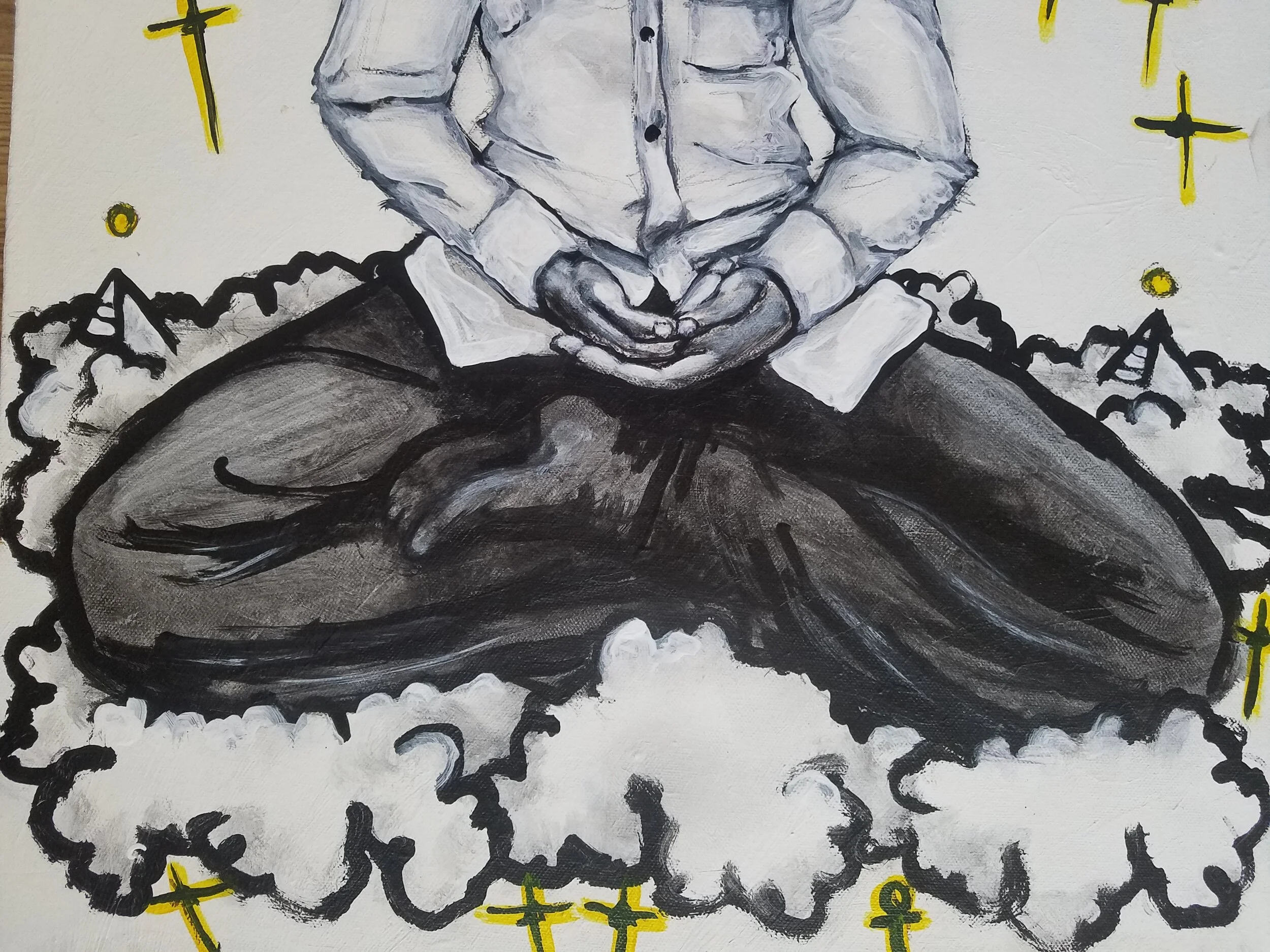Cosmic Huey
Cosmic Huey
acrylic painting on canvas with mixed media elements
20” x 26”
2019
the lotus flower is a symbol of purity, and the lotus pose is a frequent pose for meditation and pranayama, or breathing exercises. Breath is the purifying power in the human body; deep, slow breathing purifies and energizes our bodies. This spiritual meaning of the lotus flower is transferred into yoga asana practice in the form of the seated meditation posture.
Mudras are hand positions. This particular mudra is used by yogis during meditation exercises to build and improve the ability to concentrate and heal. Both hands are placed on the lap, the right hand on top of the left one, palms facing upward. In Buddhism, this mudra is displayed with the tips of the thumbs touching. This shape of a triangle represents the three jewels of Buddhism: Buddha, sangha (community) and dharma (teachings). The connection of the thumbs also represents the union of male and female principles present in every human being. This mudra represents the gesture of total balance. The person using this mudra during meditation is immersed in the limitless space, completely untouched by the outside world. The right hand symbolizes wisdom and awareness and the left one symbolizes the illusion of existence. The Black Panther Party was an organization that championed the unification of Africans of the Diaspora into one family.
This image of Huey, now and ancestor, immersed in meditation, embodies his focus and dedication to bring all of the components together to achieve the goals of the organization.
ESE NE TEKREMA “the teeth and the tongue”, derives from an image of a child's teeth. In Akan society, the appearance of a child's teeth is a sign of progress in the child's development. The teeth are a sign of growth. An individual's growth and improvement are very important in African societies. In Akan worldview, the development of the individual into a contributing social being is a noteworthy achievement for the family, the clan of the nation. The assumption of productive adulthood and responsibility guarantees continuity of the family and the nation. Such development is anticipated because the new skills and labor can be incorporated into the prosperity of the family and the nation.
Symbol of friendship and interdependence
The teeth and the tongue play interdependent roles in the mouth. They may come into conflict, but they need to work together.
The cowrie- or cowry- shell was one of the most successful and universal forms of currency in the world. In West Africa though, the humble shell worked its way into the cultural fiber, taking on a deeper symbolic and ritualistic meaning that has never been entirely lost. Many ancient cultures regarded the cowrie shell as an amulet to add vitality to life, and to prolong their lives to the point of immortality. Cowrie shells are used in divination rituals of West Africa and Afro-American religions, but also recorded in other regions including East Africa and across Asia. The cowrie's elegant shape represents the female form, its rounded top reminiscent of a pregnant woman's belly. Thus it is a symbol of fertility. The slit on the underside of the shell can look like a black pupil against a pearly white surface, which is why it is often used to ward against the evil eye. The benedictive power only enhances the elegance of the shells. Cowries are often used as ornamental beads: incorporated into jewelry, worn in the hair, decorating statues and baskets. The cowrie is a protective charm (gris-gris) adorning the outfits of hunters and warriors, woven into sacred masks and costumes for dance ceremonies. It can be an element in traditional medicine and may accompany the dead on their journeys out of this world. The Lodagaa of northern Ghana, for instance, believe that the deceased need a fee of twenty cowries to cross the River of Death and reach the land of the dead to the west.









